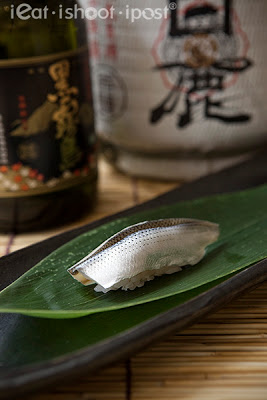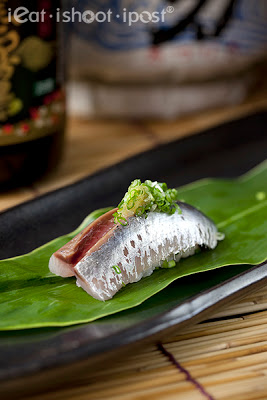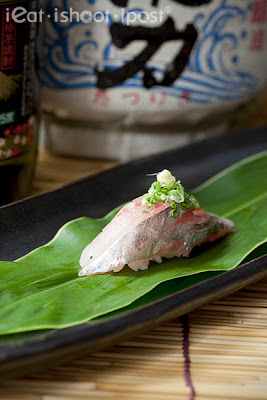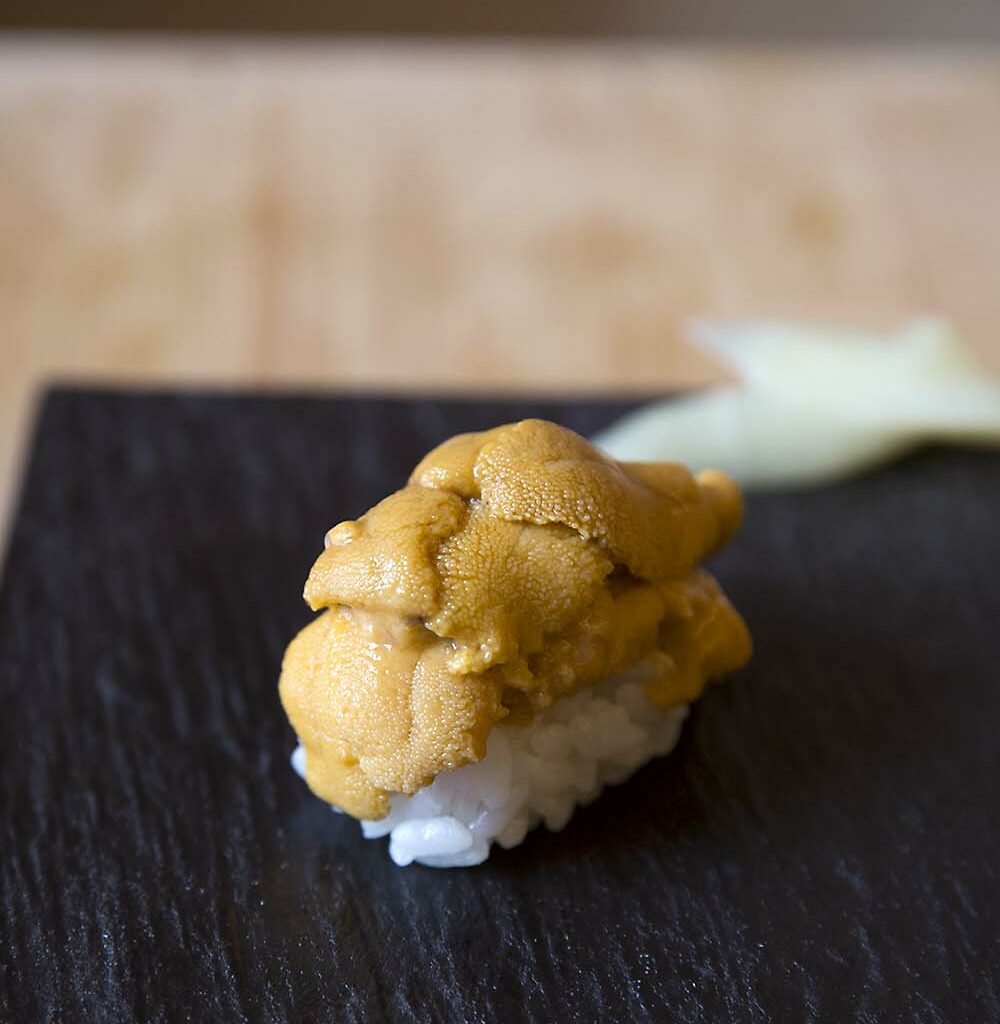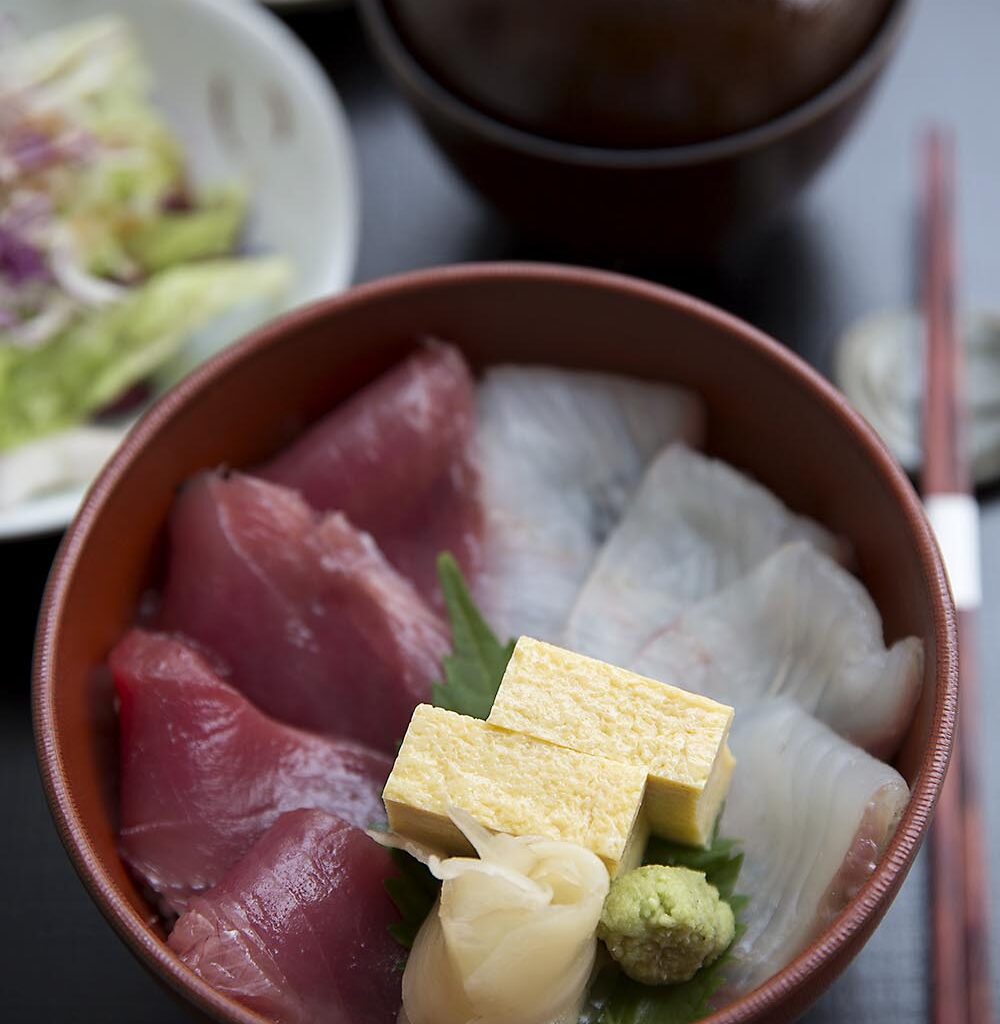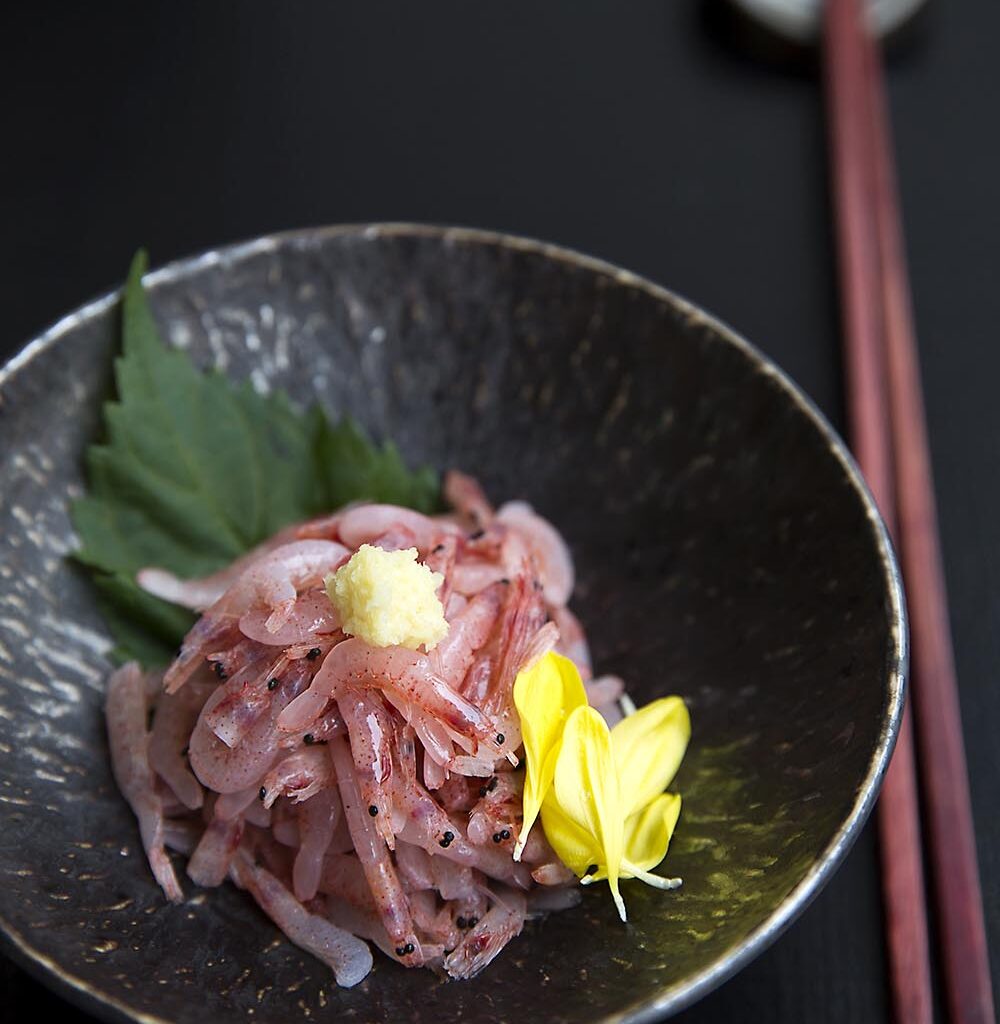Sushi Files: Hikari Mono: Kohada, Iwashi and Aji – ieatishootipost
If you are a Sushi newbie and have been aversed to fishy fish, then Hikarimono would probably be the last type of sushi you should try. Hikarimono literally means “Shiny things” in Japanese and refers to small pelagic fish which live in the water column near the surface of the ocean. They often swim in schools and are forage feeders and their flesh is full of heart protecting Omega 3 fish oils. This oil is what gives its flesh its soft and strong fishy flavour. In contrast, milder tasting, bottom feeding fish such as flounder and cod have very little fat the flesh as most of the oil is concentrated in the liver which is why we have Cod Liver Oil. These small fish are shiny and blue in order to look like the shimmering water on the surface of the ocean so that they are camouflaged from predators like Tuna and Mackeral. They usually reproduce quickly and have short lifespans, so fish such as sardines are herrings are a great choice for those concerned about sustainability and the risk of mercury poisoning as they don’t live long enough to accumulate mercury to a toxic level.
In general, the Hikarimono tend to have stronger fish flavour compared to the Shiromi-dane or white flesh fish and it is eaten precisely because of that. Those people who are fond of fishy fish would usually love it but those like myself who are a little more averse to fishy fish might take a while to appreciate the taste. While you may eat Shiromi-dane for its texture and subtle sweetness, many fish fanciers would usually want some Hikarimono towards the end of your sushi meal in order to enjoy the stronger flavour. The exception being the Kohada which is sometimes eating at the beginning of the meal in order to see how good the chef’s skills are.
There are several Hikari Mono that are commonly found in Singapore and they range in prices from the cheapest which are Iwashi (Sardine) and Aji (Horse Mackeral) to the more expensive Kohada (Gizzard Shad), Sayori and Saba (Chub Mackeral).
Kohada
This is one of those fish that the Japanese call a Shusse-uo which means that the fish is known by a different name at different stages of growth. The baby kohada is called a shinko (<5cm) and they are more expensive than the Kohada and come into season in July. When they reach 10 cm they are called Kohada and this is the usual size they serve for sushi. Then it becomes a nakatsumi before it becomes known by its proper name, Konashiro which may be around 25cm long. On a side note, you will find that many of the fish are called by the names when they are best for sushi rather than their proper names as in the case of Kohada and Hamachi. Kohada are plentiful around the waters of Japan and at the time when the Sushi culture first became popular in the Edo period, they were plentiful and cheap and at one stage even cheaper than rice. So they are sold at every street corner and Kohada is to sushi what Kleenex is to tissue paper.
Even though the fish is called a gizzard shad, it really doesn’t have an accurate English name. The American gizzard shad, Dorosoma cepedianum, is a fish belonging to a different family altogether but you can understand why they call this a Gizzard Shad as both of these fish have that distinctive long ray that sticks out of the dorsal fin like an antennae.
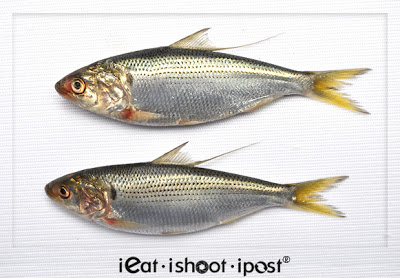
Kohada, Gizzard Shad: Konosirus punctatus
Size: Up to 30cm. Kohada is best when they are 15cm
Seasonality: Shinko appear in July and grows into Kohada through winter
The Tane
People often order the Kohada to gauge the skill of the Sushi chef. As with most Hikarimono, the fish needs to be salted first and soaked in vinegar before being made into Sushi. The salt serves to damage the outer membrane, allowing the oils of the fish to ooze out when the vinegar is eventually added. This serves firstly to kill any bacteria as well as to remove the strong fishy odour typical in small oily fish. Sound simple doesn’t it? But just how long to salt the fish depends on the weather and that will eventually determine whether the itamae manages to bring out the true taste of the fish. The best sushi bars also tend to reuse the vinegar which will develop more complex flavours when it has bathed a few fish.
Most Hikarimono have to be cured because of their high oil content. In the good old days before refrigeration, that high oil content means that the fish will turn rancid and spoil quickly. That explains why we have canned sardines which are another Hikarimono we will feature later in the post.
Kohada, which means “small skin” in Japanese has an unmistakable look. It is one of the most beautiful tane to look at, with its small delicate dots and satin sheen. The texture is more firm that the other Hikarimono and the fishiness index is a 4 out of 5. This is one fish you have to try if you want to start learning about Sushi because it is the sushi that is most recognized in Tokyo as the most popular sushi sold in the streets when Sushi first rised to popularity back in the early 1800’s.
Iwashi
There are many fish that are called Sardines. Actually the fish is named after Sardinia, a region in Italy where they used to catch huge numbers of fish. These fish form the bottom of the food chain and are eaten by many of the larger fish like swordfish and tuna. They are very oily fish and contain lots of Omega 3 fatty acids. But because of the amount of fat, they go bad very quickly and so a lot of the fish are preserved by canning. In Japan, they are cheap fish that is eaten by the masses but only became a popular fish for sushi in the modern era when refrigeration could preserve the fish for long enough to be eaten raw.
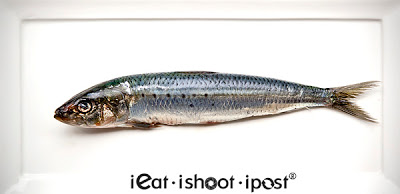
Iwashi, Sardine, Sardinops Sagax
Size: 22cm
Season: Autumn (Sep-Oct)
The Tane:
These are beautiful fish when presented as Sushi. Unless the Itamae can get hold of absolutely fresh Iwashi, they would often be marinated in salt and vinegar before serving. Usually ginger and chopped shallots are also added to help cut through the oil and fishiness. This tane is easily recognized by the sliver skin and the presence of tiny bones which are perfectly edible especially if they have been softened after soaking in vinegar. The best Iwashi are eaten when they are just about to spawn in Autumn which is when they get to be their fattest. If you like your fish fishy, this one is bang for the buck! The fishiness index can get to 5 out of 5 if the fish is anything less than staight out of the water onto your sushi plate!
Aji
It’s amazing when you consider the price difference between the Aji which comes from Japan and a local fish which is very similar, the Kembong. The Aji can cost $80 per kg while our Selar is so cheap that a $2 packet of nasi lemak can have one fish. It all boils down to how the Japanese handle their fish. If you look closely at the photo, you will notice a little nick just behind the eyes of the fish. This give you a clue as to how the fish was killed. When I visit fishing villages in Malaysia, I often see piles of fish on decks of fishing boats which have been left to die of suffocation. Then they are off loaded onto the market floor with a bit of ice to be sold. They are great deep fried or to be made into curry, but you can’t eat them for sashimi. The Japanese treat their fish very differently. They will try to kill the fish in a way that they are not stressed. Often that means that they place them into very cold salt water and they are killed by a stab into the hind brain and put on ice immediately. So it is that care and attention to detail that enables them to sell one piece of Aji Sushi for $8 while a whole Kembong might go for $1 each.
The Horse Mackeral is not really a Mackeral. It actually belongs to the same Jack family of fish as the Kanpachi and Hamachi. It’s probably called a Horse Mackeral because of its large eyes that make it look a little like a horse. In Japan, they use the prefix “Ma” to refer to the proper fish for sushi which in this case would be the Trachurus Japonicus. So you may have many species of Aji around, but it is Ma-aji that you are looking for when eating sushi. The prefix “Ma” which means “true” in Japanese is used for many other fish species such as Madai. The prefix “Hon” also has a similar meaning (real in Japnanese) and it is used for fish like Hon Maguro. I asked my Japanese friend about this and there isn’t really an explanation except that perhapse Ma-Maguro would sound a bit funny.
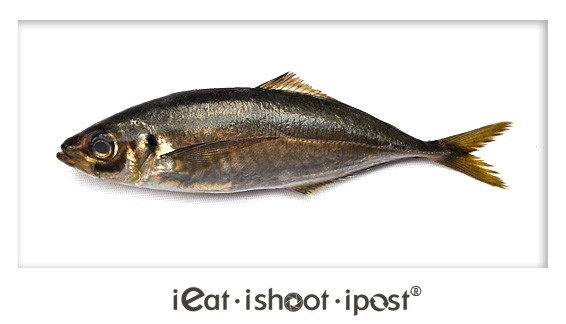
Aji, Horse Mackarel, Saurel, Trachurus Japonicus
Seasonality: Spring and Summer
The Tane
This fish may be related to the Shima Aji (Striped Jack) but unlike the fresh, sweet tasting Shima Aji, the Aji is a fishy fish especially if it is anything less than absolutely fresh. The Japanese word for “Tasty” is also Aji as in Aji-no-moto or “Essence of Taste” and for those who enjoy strong tasting fish, this one will hit all the right buttons. It is usually taken with some ginger and spring onions. Depending on the quality of the fish, Aji can score a 5 out of 5 on the fishiness scale so if your are aversed to fishy fish, you have to make sure that your Aji is absolutely fresh.
Acknowledgement
The photos are made possible through the help of my friends at:
Hokkaido Sushi
M Hotel, Level 9
81 Anson Road
Tel: +65 6500 6121
Special Sushi Set for ieatishootipost readers
Hokkaido Sushi’s $70++ Sushi Omakase set is a great place to start your Sushi exploration. This offer will run till the end of the year. The set consists of a starter, five piece sashimi, 15 pieces of sushi which includes otoro and uni, Teriyaki beef, Akadashi Soup and coffee or ice cream. Just tell the waitress you are ordering the ieat Sushi Omakase set.
Sushi is Safe to eat! Please read my article on Radiation and Seafood Safety.
Resources:
Sushi Experts: Chef Thomas of Hokkaido Sushi and Shinji Sakamoto of CWT Fresh
References:
1. The Connoisseur’s Guide to Sushi: Dave Lowry, Havard Common Press, 2005
2. Sushi: Food for the eye, body and soul: Ole G Mouritsen, Springer Science, 2009
3. Sustainable Sushi: Sustainable Sushi: Cassen Trennor, North Atlantic Books, 2008



